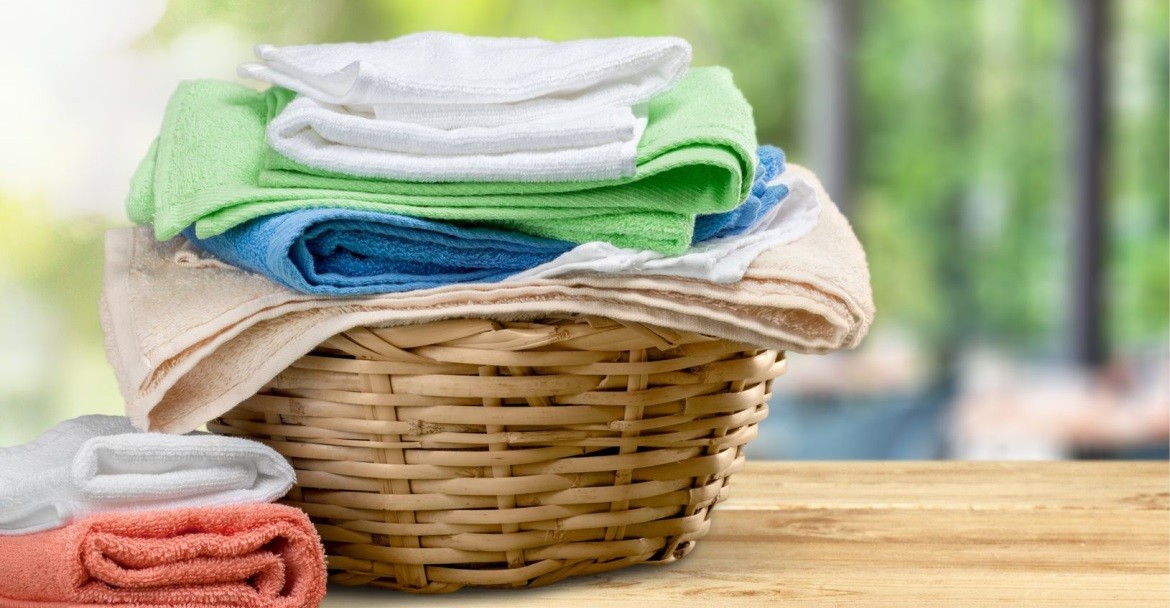
Washing clothes. How to avoid mistakes and not mess things up
Have you ever studied washing badges on clothes, wondering what exactly is viscose or linen and how to wash them correctly? You can wear clothes from these fabrics every day, but have no idea what it is or how it is behind it look after. This last point is especially important, since even the best fabric will not last long if you do not follow the rules of washing your clothes.
Always check the laundry icons on the clothes before starting the washing machine. If you do not know what these or those symbols mean, our overview on decoding clothing care signs will help you to understand .
Let's take a look at the most common types of fabrics and talk about how they require care.
Cotton
Natural fiber obtained from ripe cotton bolls
- Cotton clothes are washed at a high temperature (boiling water does not damage the fibers of the fabric)
- Delicate spin
- Iron slightly damp clothes with a hot iron
- Any good detergent is suitable for washing clothes
- For white cotton you can use chlorine bleach, for dyed garments you can use stain remover for colored fabrics
- Cotton wrinkles easily. Before ironing, the fabric can be treated with a starch spray, which will create a fairly stable wrinkle effect
- Cottons take longer to dry than other fabrics, therefore a higher temperature is recommended for tumble drying
- (See the washing badges sewn onto the clothes for specific care instructions)
Linen
Natural fiber from flax stems. Hemp and jute are similar to flax, but the plants are processed slightly differently
- Some linen is washable, while others can only be dry cleaned (check the care label on the label)
- Dry cleaning is recommended to preserve the original freshness of the fabric
- Hand wash with mild detergent without chlorine bleach, dry flat on a clean, unpainted towel
- Washing linen clothes makes the fabric softer and more pleasant to the body
- It is recommended to dry white linen in the sun, this will help the fabric to maintain its whiteness
- Linen is easily wrinkled and requires frequent ironing, if not specially treated for creases
- (See the washing badges sewn onto the clothes for specific care instructions)
Wool
Natural fiber from animal hair: sheep, goats, alpaca, llama, camel
- We recommend dry cleaning once a season, especially before storage (small dirt can be cleaned with a damp sponge)
- Give woolen garments a 24-hour rest between wears
- Store on hangers, leaving plenty of space between clothes (wool fibers will straighten, returning to their original shape)
- Take everything out of the pockets, remove the straps and hang with the fasteners and zippers
- Knits Fold
- Steam will help restore the shape of woolen garments after wearing or unpacking. Hang your clothes up in the steamy bathroom for a while
- If the wool gets wet, dry it at room temperature, away from heat sources
- Remove spots that appear quickly
- Juniper, lavender and fir essential oils will help prevent moths from appearing in the closet
- Avoid ironing wool. If there is such a need, always use steam and wool mode .. Raise and lower the iron, do not move it back and forth
- (See the washing badges sewn onto the clothes for specific care instructions)
Silk
Natural fiber from the silkworm cocoon.
- Dry cleaning is recommended as detergents and dyes on other garments can negatively affect the condition of silk
- Follow the care instructions carefully when washing washable silk garments
- Delicate hand wash with mild soap and lukewarm water is acceptable
- Do not use chlorine bleach when washing silk
- Dry horizontally on a clean, unpainted towel
- Only pre-washed silk can be washed. Be sure to read the label
- Silk products should be protected from light, air and insects during long-term storage
- (See the washing badges sewn onto the clothes for specific care instructions)
Leather
- Store leather clothing in a well-ventilated place, outside the laundry basket
- Air dry wet clothes, away from heat sources
- Remove small stains as soon as possible with special soap soap
- Use quality skin varnishes and sprays
- Use a professional dry cleaner to remove serious stains
- (See the washing badges sewn onto the clothes for specific care instructions)
Acrylic
Artificial fabric, soft, lightweight and elastic, reminiscent of wool. The material does not cause allergic reactions, dries quickly, does not absorb moisture.
- Machine wash, dry cleaning
- Machine wash at water temperature not exceeding 30 ° С. We recommend using fabric softener
- Tumble dry at low temperature. As soon as the clothes are dry, immediately remove them from the tumble dryer
- Wash delicate items by hand in warm water
- Static electricity stored in acrylic cloth can be removed by using fabric softener every third or fourth wash
- Careful, delicate wringing. Straighten or shake clothes and let dry on a hanger
- Sweaters knitted products to dry in a horizontal flat position
- Iron at very low iron heat or avoid ironing at all
- (See the washing badges sewn onto the clothes for specific care instructions)
Nylon
The most versatile fiber used to make fabrics. In addition to hosiery and sportswear, nylon is used in underwear and wedding veils. It is stronger and weighs much less than any other fiber. Nylon is elastic, smooth, does not absorb moisture and dries quickly.
- Most nylon items are machine washable and tumble dry at low temperatures
- Wash clothes at 30 ° C, use fabric softener when rinsing
- Dry flat, away from artificial heat sources and direct sunlight
- If ironing is required, use a lukewarm iron
- (See the washing badges sewn onto the clothes for specific care instructions)
Polyester
Durable artificial fiber, does not wrinkle, retains its shape. The blend of polyester and cotton gives the fabric increased strength and durability. Hydrophobic polyester, dries quickly.
- Most polyester items are machine washable and tumble dry
- The water temperature for washing clothes depends on the percentage of natural fibers and polyester in the fabric, please pay attention to the icons on the clothes to be washed. Use fabric softener
- Tumble dry at low temperature or away from sunlight
- Iron on medium heat
- Most polyester products are dry cleanable
- (See the washing badges sewn onto the clothes for specific care instructions)
Viscose
Fiber obtained from natural cellulose processing has many of the qualities of cotton. May resemble linen, silk, wool. Durable, moisture wicking, non-melting, drape well and has a soft silky appearance. Viscose wrinkles easily and can shrink during washing.
- Requires hand, delicate wash. Use warm or cool water and lather
- Do not wring or twist clothes
- Smooth or shake the product and let it dry on a hanger away from direct sunlight and radiators
- Dry viscose sweaters horizontally
- Iron the garment damp (or through a damp cloth) from the wrong side with low iron heat
- (See the washing badges sewn onto the clothes for specific care instructions)
Sorting laundry before washing

- Sort laundry by color: white to white, dark to dark, color to color
- Separate artificial fabrics such as polyester from natural fibers such as cotton. Man-made fibers can absorb oils produced by natural fabrics during washing. These oils can build up and make stains on clothing more visible
- Wash heavily soiled clothing separately from slightly soiled items. This will prevent fading and help keep colors vibrant
- Try to load the washing machine with large and small items at the same time. This will allow the clothes to move more freely in the drum during washing
- Separately sort delicate items and harder fabrics
- Lint-flocked clothing such as fleece sweatshirts and towels should be washed separately
- Previously, vinegar was added to the water for washing fading things to fix the color. This does not work with modern dyes. So if your clothes fade while washing, keep washing them separately
How to get rid of fabric stains
Blood. It is necessary to treat the stain with a mixture of cold water and table salt (2 tablespoons of salt per 1 liter of water). Rinse and pat dry with a towel. If the stain persists, try using diluted ammonia.
Wax. There are several ways to get rid of wax stains. First, carefully remove the wax from the surface of the fabric with a spatula or dull knife. Now you have two options: spot cleaning with a water-free solvent, or covering the stain with several layers of paper towels, which you then iron with an iron to heat the wax and make it easier to remove.
Chewing gum. All you have to do is freeze the gum with ice and then remove it with a spatula or blunt knife.
Chocolate and coffee. Quite light stains that are removed from the fabric with a sponge dipped in warm water.
Ink and markers. Use rubbing alcohol.
Dirt. The first step is to remove whatever is possible with a spatula or dull knife. Let the dirt dry and then vacuum clean it. If the stain persists, wipe it off with a cloth or sponge dampened with an ammonia-water solution.
Wine and alcohol. Stains of this kind can only be removed with special stain removers. Make sure the fabric can be treated with the product of your choice and be careful not to over-wet.
Some stains are easier to remove than others. There are many factors that affect how difficult it is to remove a stain from fabric, including how old it is. If you do not know how to remove a stain or are in doubt about your abilities, it is better to entrust it to professionals.
Tips for washing clothes
- Be sure to check the badges on the clothes for washing, follow the instructions and symbols
- Do not overload the washing machine. If it is too full, the clothes will not mix well enough in the drum and will not clean well, and the powder may not dissolve and remain on the fabric
- Be sure to check your pockets before washing and drying. Just imagine the stains and damage you can get if you accidentally leave your lipstick, chewing gum or pen in your pocket

